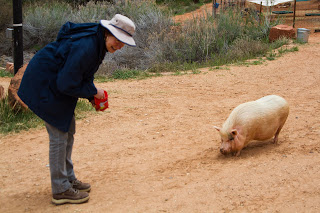Finally, on a very cloudy day that failed to inspire me to go for a scenic destination, I decided to re-visit the Best Friends Animal Society that is only a few miles outside Kanab. If you're not familiar with this facility, please go to their web site and read their amazing story (http://bestfriends.org/). I believe they were the first animal sanctuary to espouse a "no kill" policy. Through their efforts, this policy is now widespread and saves millions of animal lives each year. Best Friends is recognized around the world for their good work protecting and giving homes to abandoned, unwanted, injured and abused animals. The founders have sacrificed a great deal to accomplish all they have.
I did not take the official tour this time, but drove through and stopped where it was practical. The growth in the operation since my 2006 visit is astounding, both in the numbers of various animals and physical facilities to support them.
In the 1980s, Best Friends purchased a large tract of land in Kanab Canyon, now informally known as Angel Canyon, where they built this sanctuary from the ground up..
New cabins and cottages are said to be available (at a modest cost, I'm sure) for both volunteers and those who simply need a place to stay.
The Visitor Center is one of the older buildings.
From one or two horse corrals, there are now many such facilities and many more horses using them. It's perfectly obvious, too, that employees and volunteers love their assigned animals, and welcome visitors.
Even the lone burro has a great life here.
There are several "cat houses", but I wasn't able to go inside since I wasn't part of a tour. However, I got a few photos of cats enjoying their "outdoor" playgrounds.
In 2006, I saw one pot-bellied pig. On this trip, there were a dozen or more. As you might expect, volunteers and visitors enjoy spoiling the pigs.
In addition to dogs, cats, rabbits goats and horses, the sanctuary also houses a variety of birds, including parrots, and various wild animals. I saw on building labeled "Bear House", but that seems hard to believe. Wild turkeys roam the grounds, and why would they ever leave?
The most touching place on the grounds is known as Angel's Rest, where deceased animals are buried. It is many times larger than when I was here before, with what appears to be thousands of grave sites. There is a stone for each grave and a small rock on which the animal's name is painted. In addition, small baubles, such as stones, glass trinkets, etc, are placed on the graves. Wind chimes are located around the cemetery with weights containing the name and/or photo of a beloved animal. Whatever these animals may have endured before coming here, they ended their lives in a caring and loving situation.
Anyone looking for a worthy organization to make a donation should give serious consideration to Best Friends. Their web site tells how it can be done. Also, many people combine a vacation with their volunteer work here. Sounds like a win-win to me.
Success here has led to expansion into other regional locations. Best Friends operates pet adoption centers, spay/neuter clinics and no-kill initiatives in Los Angeles, New York City and Salt Lake City, as well as a No More Homeless Pets Network of animal rescue groups in every corner of the nation. None of these is likely to match the beauty and ambience of Angel Canyon.




























































